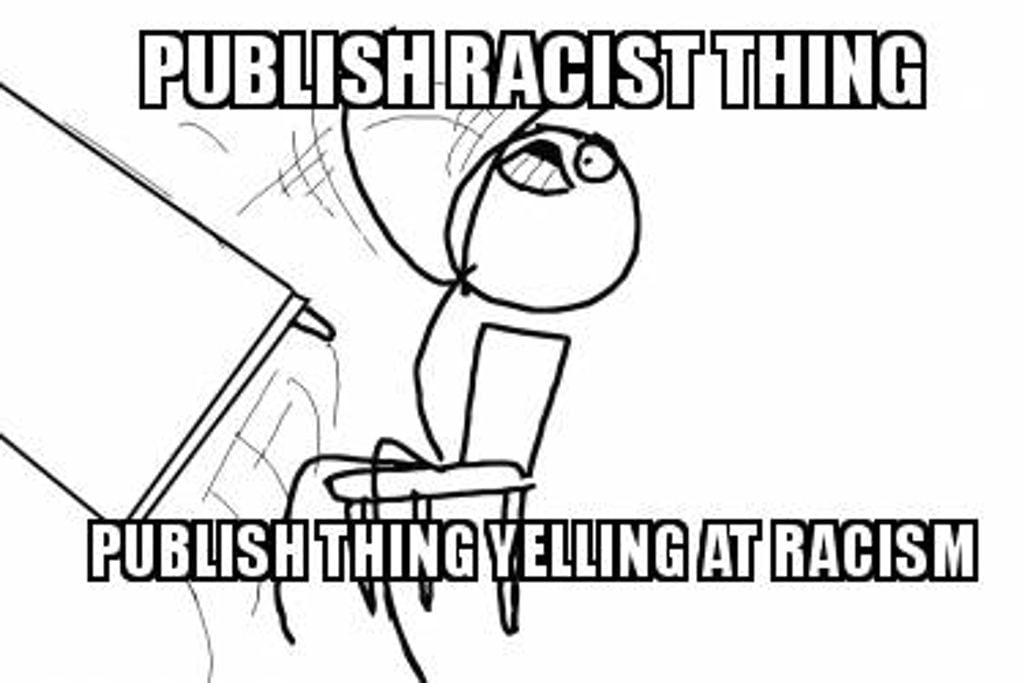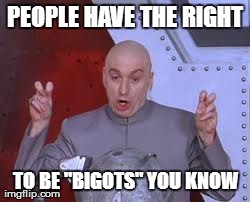This “Let’s Anger Our Readers For Clicks” Thing Needs To Stop
Seriously. Stop it.

It’s 2014, and legacy media has finally realised the new news economy is in clicks, not in classifieds. Print mastheads have erected paywalls and content quotas to save their ever-thinning rivers of gold. But among the hyper-cheery headlines of Upworthy and cat gif listicles of Buzzfeed, a weird new genre of clickbait has arisen: the “Outrage-Sorry!” Industrial Complex.
The “Outrage-Sorry!” Industrial Complex
One of the most prominent reported sightings of this media phenomenon came in May last year, during the bedlam of Mia Freedman’s less-than-seminal critique on Australian race relations, “MIA: The boy who cried ‘Racist’”.
Defending a retweet of Delta Goodrem’s — a photo which depicted and poked fun at blackface — Mia wrote: “Using words like ‘racist’ to describe the retweeting of this photo diminishes and dilutes the power of that word. I worry that by over-using it, we render it almost meaningless.”
Yes, Mia. But another way to render “racism” meaningless is to put a pin in any person of colour who’s just called out intolerance and bigotry.

According to the site’s metrics, the piece was shared over 1,500 times on social media. If the comments section is anything to go by, most were out of fury rather than furious agreement.
Only a day passed before the site scrambled to distance itself from Mia’s polemic, publishing a rebuttal by Meshel Laurie which asked: “Do white people have the right to decide what’s racist?” (Read: no.)
The format has been used more recently by the Sydney Morning Herald, following Fairfax columnist Annabel Crabb’s sanctimonious dismissal of student protestors. Angry kids at uni were using ineffective “Soviet-era” tactics in our glorious age of hoverboards and flying cars, Crabb wrote.
The SMH is a big fan of the “Outrageous and offensive piece followed up with a warm and fuzzy liberal perspective on the issue” tactic.
— Osman Faruqi (@oz_f) June 13, 2014
Of course, the piece was swiftly rebuffed by the very Yoof she was chastising. But the Herald got the last laugh — and the lion’s share of clicks — by publishing this smackdown from student activist Tom Raue four days after the first bomb had been lobbed.
Raue’s response was sharp and blistering, but ultimately the exchange presented a milquetoast “balanced” approach to the subject, kicking the much vaunted 19-25 demographic into a heated frenzy on Friday, then offering them an ice-cold popsicle the following Tuesday.
A couple of weeks later Fairfax took it to the next level. Twitter was again ablaze over occasional film critic and bigot Mark Sawyer’s thundering analysis, “How racist are you?”
“How many people alive today are honest to god racist?” Sawyer wrote. “You know, willing to stand at the school gates like a southern US governor in the 1950s and ’60s and say non-white children will not pass? Refuse to shake the hand of a non-white person?”
Look Mark, you’re right. We don’t separate our schools; instead, we now effectively segregate our prisons, with Indigenous Australians fifteen times more likely to be incarcerated than the rest of the population. And let’s not forget the Attorney-General’s declaration that Australia should be open for bigots.

This time around, Fairfax was even swifter in its syrupy follow-up. Herald journalist Aparna Khopkar’s excoriating reply-piece “Racists cannot be let off the hook just because they are stupid” was written, filed, proofed and published within a day. I’m not cynical of Khopkar’s critique, or the expediency with which she wrote it. Her response and cited experiences were powerful and visceral.
What I’m skeptical of is the editorial direction that permits Sawyer’s piece to be printed in the first place. I’m skeptical of the back-and-forth, values-neutral vehicle that these newspapers purport themselves to be.
“Sorry, Not Sorry”: Editors
Last October, the LA Times announced it would no longer print the letters of climate change deniers. It signaled a rejection of the pseudo “false equivalence” dichotomy that’s plagued newspapers since the post-mortem of modernism.
It also marked an acceptance that not all ideas are equal. Why should editors give space and platform to the anti-science crowd, when a consensus exists (or at least 97% certainty) among climate scientists that humankind is contributing to the warming of the planet?
Similarly, is it too much to ask that petulant racism not be given such a platform? That we shouldn’t turn to the uninformed social commentary of unaffected white people on national race relations? Probably, hey.
New Matilda’s Chris Graham offered the following advice the same day as Khopkar’s story hit stands: “Don’t swallow the bait. Don’t click on their stories… If you still feel an overwhelming desire to knock down the myths, then share their stories by copying and pasting the text into your newsfeed. And when a little Herald notice pops up on your screen to warn you that you’ve read 29 out of your 30 stories for the month, go to your preferences and clear your cache.”
Worryingly, the consequences of this bizarre media landscape can already be felt.
The Australian’s recent crusade against plain packaging on cigarettes isn’t exactly groundbreaking stuff. A Murdoch masthead on the side of big business is a slow Monday. That the paper can, in the same sputtering breath, use data released by tobacco giant Phillip Morris to blame the former Labor government is just the nicotine-flavoured icing on the cake. Of course, The Australian’s report was roasted by Media Watch, Treasury, and economists. But it didn’t stop there.

Economics correspondent and part-time deathstick dealer Christian Kerr put on his detective’s fedora and questioned the Treasury’s evidence in a piece titled “Cigarette-makers question new data”. The headline has subsequently left philosophers to seriously question whether tragedy really does precede farce.
But what’s most alarming about The Oz’s campaign is its naked nudging: pushing the false binary that figures supplied by Phillip Morris are somehow as credible or impartial as Treasury data.
Having gone out guns blazing in its front-page exclusive, every successive follow-up wasn’t really an attempt to advance the story’s central claims. Rather, each deployment was another inch gained in support of the proposition that all opinions, and data, are equal.
It’s in this warped worldview that a scientist’s opinion is commensurate to that of a pastor’s, and a white dude’s take on racism is as valuable as a person of colour’s.
Memo To Media Outlets: Don’t Be Evil
A few instances may not a trend make, but it’s worrying all the same. News outlets shouldn’t distribute ignorance for the sake of a few rage-fuelled clicks. It’s not fair to cast blame on those afflicted, offended and outraged for responding to these kinds of stories. It’s a form of victim-blaming that posits that those who’ve been belittled ought to keep a stiff upper lip in the face of blithe stupidity. Ultimately, it’s the editors who should be held responsible for engaging in this foul brand of clickbait.
Writing for Guardian Australia early last November, Steve Hind suggested: “Those of us who care about traditional media outlets and serious journalism need to pick our battles. The giants of the industry are under serious threat and have to adapt quickly in the face of threats from more nimble rivals. Let’s give them a pass on the clickbait, and keep the focus on the quality of the content.”
His advice is solid. Legacy media shouldn’t offer Lord Monckton a column on the promise of a bunch of angry clicks. Let’s focus on the quality of the content, and keep in mind that race-baiting only harms it.
–
Justin Pen is an editor of esteemed Sydney Uni rag Honi Soit. He tweets @justipen.